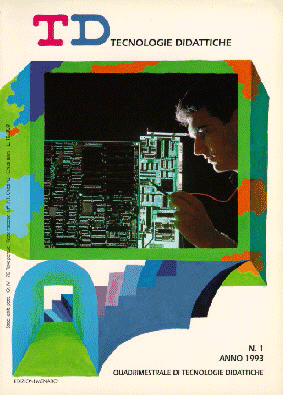Birth and development of educational technology
Main Article Content
Abstract
Article Details
Authors who publish with this journal agree to the following terms:
- Authors retain copyright and grant the journal right of first publication with the work simultaneously licensed under a Creative Commons CC BY 4.0 Attribution 4.0 International License.
- Authors are able to enter into separate, additional contractual arrangements for the non-exclusive distribution of the journal's published version of the work (e.g., post it to an institutional repository or publish it in a book), with an acknowledgement of its initial publication in this journal.
- Authors are permitted and encouraged to post their work online (e.g., in institutional repositories or on their website) prior to and during the submission process, as it can lead to productive exchanges, as well as earlier and greater citation of published work (See The Effect of Open Access)
References
Alpay L. (1989), Developmental User Models, Interactive Learning International, vol. 5, n. 2, pp 79-86
Bednar A.K., Cunningham D., Duffy T.M., Perry J.D. (1991), Theory into Practice: how do we link?, in Instructional Technology: past, present and future, Anglin G.J. ed., Englewood, CO: Libraries Unlimited
Berlo D. (1968), The process of Communication, Holt, Rinehart & Winston, New York
Brown J.S., Collins A., Duguid P. (1989), Situated Cognition and the Culture of Learning, Educational Researcher, vol. 18, n. 1, pp 32-42
Carbonell J.R. (1970), AI in CAI: An artificial Intelligence Approach to Computer Aided Instruction, IEEE Transaction on Man Machine Systems, vol. 11, n. 4, pp 190-202
Cox M.J. (1992), The Computer in the Science Curriculum, International Journal of Educational Research, vol.17, n.1, pp 19-35
Crowder N. (1960), Automatic Tutoring by Intrinsic Programming, in Teaching Machines and Programmed Learning,Lumsdane A.A. and Glaser R. eds, N.E.A., Washington
Cunningham D.J. (1991), Assessing Construction and Constructing Assessments: a Dialogue, Educational Technology, vol. 31, n.5
Dale E. (1969), Audiovisual Methods in Teaching, Dryden Press, Hionsdale
Duchastel P.C. (1990), Cognitive Designs fo Instructional Design, Instructional Science, vol.19, n.6, pp 437-444
Elsom Cook M. (1989), Microtutors, an Introduction to Intelligent Tutoring Systems, Paul Chapman Publ., Londra
Ferraris M. (1993), TD nella Scuola Italiana: se ci sei batti un colpo, TD, vol. 1, n.1
Ferraris M., Midoro V., Olimpo G. (1984), Instructional Systems Design and Software System Design: a Unifying Approach, Journal of Structural Learning, vol.8, pp 55-61
Ferraris M., Olimpo G. (1985), L’evoluzione delle tecnologie didattiche, La scuola Se, vol.3, n.2
Fontana Tomassucci L. (1971), Istruzione programmata e Macchine per Insegnare, Armando Editore
Frau E., Midoro V., Pedemonte G.M. (1992), Do Hypermedia Systems Really Enhance Learning? A Case Study on Earthquake Education, ETTI, vol.29, n.1, pp 42-51
Gagné R.M. (1970), The Conditions of Learning, Holt, Rinehart & Winston, Londra
Gagné R.M., Briggs L.J. (1979), Principles of Instructional Design (sec. ed.),Holt, Rinehart & Winston, New York
Hannafin M.J. (1991), Emerging technologies, ISD, and learning environments: critical perspectives, Educational Tecnology Research and Development, vol 40, n.1, pp. 49-63
Hilgard E.R., Bower G.H. (1966), Theories of Learning, Appleton Century Crofts, New York
Hoban C.F. (1974), A Current View of the Future of Theory and Research in Educational Communication, Audiovisual Instruction
MacKenzie D. (1990), An Expert System Approach to Authoring Tool Selection, Educational Technology, vol.30, n.12
Mandl H., Renkl A. (1992), A plea for more local theories of cooperative learning, Learning and Instruction, vol. 2, n.3, pp.155-159
Merril M.D. (1971), Instructional Design: Readings, Educational Technology Publ., Englewood Cliffs
Merril M.D. (1991), Constructivism and Instructional Design, Educational Technology, vol. 31, n.5
Nicol A. (1990), Interfaces for Learning, Bagley C., Hunter B., in The Art of Human Computer Interface Design, Laurel B. ed., Addison Wesley, New York
Pressey S. (1960), A Simple Apparatus which gives tests and scores and teaches, in Teaching Machines and Programmed Learning, Lumsdane A.A. and Glaser R. eds, N.E.A., Washington
Riel M. (1990), Cognitive Learning across Classrooms in Electronic Learnign Circles, Instructional Science, vol.19, pp 445-466
Romiszowsky A.J. (1991), Expert Systems in Education and Training: Automated Job Aids or Sophisticated Instructional Media, in Expert Systems and Intelligent Computer Aided Instruction, Educational Technology Publications, Englewood Cliffs
Saettler P. (1968), A History of Instructional Technology, Mc Graw Hill, New York
Sandberg J., Wielinga B. (1992), Situated Cognition: a Paradigm Shift?, Journal of Artificial Intelligence in Education, vol. 3, n. 2, pp 129-138
Sanna R., Bozzo E., Gemma A. (1974), PROMIX 2, An Audiovisual Display System for Educational Purposes, Rapporto Tecnico CNR-ITD
Skinner B.F. (1954), The science of learning and the art of teaching, Harvard Education Review, vol.24, Spring
Skinner B.F. (1968), The Technology of Teaching, Appleton Century Crofts, New York
Spector J.M., Gagné R.M., Muraida D.J., Dimitroff W.A. (1992), Intelligent Frameworks for Instructional Design, Educational Technology, vol.32, n.10, pp 21-28
Spiro R.J., Feltovich P.J., Jacobson M.J., Coulson R.L. (1991), Cognitive Flexibility, Constructivism, and Hypertexts, Educational Technology, vol. 31, n.5
The Educational Technology Anthology Series, Telecommunications for Learning, Educational Technology Pubblications, Englewood Cliffs
Vygotsky L.S. (1978), Mind in Society: the Development of Higher Psychological Processes, Harvard University Press, Cambridge, Mass.

